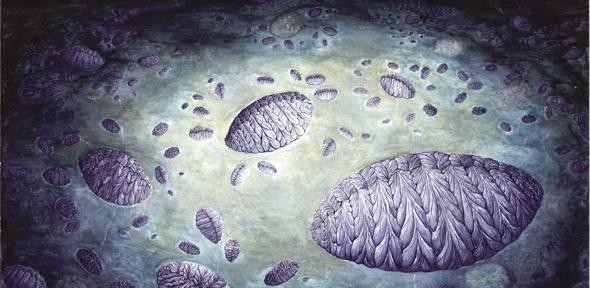Scientists have uncovered evidence of the first reproduction act in animals from a soft, fern-like ancient sea creature that thrived in the world's oceans some 565 million years ago that suggests how sexual procreation first began in a complex organism, according to this new study.
These creatures called rangeomorphs are considered to be one of the world's first complex animals however researchers are still stumped as to what exactly these animals are. The animals lived in a marine a environment during the late Ediacaran period, that is between 580 to 541 million years ago, before the Cambrian era began. The rangeomorphs can grow up to 6.5 feet in length however, most of them only reach up to 4 inches long.
Some of the bizarre characteristics of the rangeomorphs include, they are not built with mouths or even organs or even equipped with the ability for movement since the creatures just absorb nutrients from the surrounding water, according to researchers.
However, their reproductive process is considered to be complex as these ancient organisms apply a unique strategy by sending out an advance party to perform reconnaissance when it comes to settling into a new area or region before colonizing that specific area.
According to lead author of the study Emily Mitchell from the University of Cambridge, the rangeomorphs are not even remotely similar to any fossilized records which is a big mystery for scientists. However, the team has developed a new method of observing them to gain a better understanding of these complex creatures, more so on their reproduction processes.
Mitchell and her team found the rangeomorphs fossils called Fractofusus in Newfoundland, southwest Canada. Similar to other rangeomorphs, the Fractofusus is also immobile meaning the fossils are in the exact location where the creatures once lived during the Ediacaran period.
The researchers used statistics and higher resolution GPS including computer modeling where they discovered a unique pattern among the distribution of Fractofusus populations. Larger Fractofusus or "grandparent" samples were located in random places around a colony that are surrounded by smaller populations.
This pattern is also observed in biological clustering especially in modern plants where they probably have two reproductive methods. Grandparent specimens most likely originate from ejected spores where the smaller specimens have grown from runners sent by older generations similar to modern strawberry plants.
Researchers believe that these new findings can provide a better understanding of the early beginnings of modern marine life. This new study is published in the journal, Nature.



























